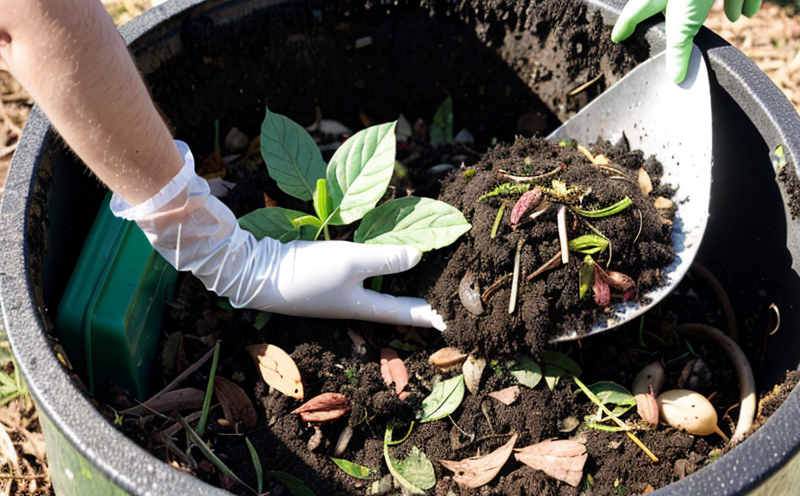EPA Method 1680 Fecal Coliform Testing in Biosolids/Compost
The EPA Method 1680 for the detection of fecal coliforms is a critical tool used to ensure that biosolids and compost materials meet stringent microbial safety standards. This method employs membrane filtration followed by incubation under specific conditions, allowing for the enumeration of viable fecal coliform bacteria in samples.
Composting and treatment processes generate biosolids which, when applied to agricultural land, can potentially introduce pathogens into the environment if not properly treated or managed. To mitigate this risk, regulatory bodies like the EPA have established guidelines requiring routine testing using standardized methods such as Method 1680. This ensures that these materials are safe for use and do not pose a public health hazard.
Method 1680 is particularly important because it provides a reliable way to assess the microbial quality of biosolids intended for agricultural reuse or land application. The test measures fecal coliforms, which serve as indicators of potential pathogen presence since their presence suggests that other harmful microorganisms may also be present.
The process involves collecting representative samples from the biosolid or compost pile, filtering them onto membranes, and then incubating the filters under conditions conducive to the growth of fecal coliform bacteria. After an appropriate incubation period, colonies are counted and compared against established criteria to determine compliance with regulatory limits.
Understanding the specifics of how this method works is essential for quality managers overseeing biosolid or compost production processes as well as for R&D engineers working on improving these materials' safety profiles. Compliance officers must ensure that all required tests are conducted correctly according to EPA guidelines, while procurement teams need accurate test results to verify that purchased materials meet regulatory standards.
In summary, EPA Method 1680 plays a vital role in ensuring the microbial quality of biosolids and composts used for agricultural applications. By providing a standardized approach to detecting fecal coliform bacteria, this method helps protect public health by reducing risks associated with pathogen transmission from these materials.
Scope and Methodology of EPA Method 1680 Fecal Coliform Testing in Biosolids/Compost
| Component | Description |
|---|---|
| Sample Collection | Representative samples are taken from various points within the biosolid or compost pile. |
| Membrane Filtration | The collected sample is filtered through a membrane that retains fecal coliforms. |
| Inoculation | The filtered membranes are inoculated with nutrient broth containing glucose, which supports the growth of fecal coliforms. |
| Incubation | The inoculated membranes are incubated at 44.5°C ± 0.2°C for 24 hours to allow for optimal growth conditions. |
| Colonies Counting | Viable colonies of fecal coliforms on the membrane are counted after incubation. |
| Reporting | The total number of viable colonies is reported according to EPA guidelines. |
This table outlines the key steps involved in conducting EPA Method 1680 testing. Each step serves a critical purpose in ensuring accurate and reliable results, ultimately contributing to meeting stringent microbial safety standards for biosolids and compost materials.
The process begins with thorough sample collection from multiple locations within the biosolid or compost pile to ensure representativeness. Following filtration, the membranes are inoculated with nutrient broth containing glucose, which provides a suitable environment for fecal coliform growth. Incubation at 44.5°C ± 0.2°C allows sufficient time for viable colonies to develop before counting begins.
The final step involves carefully counting all visible colonies on the membrane after incubation. This count is then compared against regulatory thresholds set by the EPA, ensuring that biosolids or compost meet safe levels of fecal coliforms.
By adhering strictly to these procedures and using high-quality equipment, laboratories can produce accurate results that comply with EPA standards and provide confidence in the microbial safety of biosolid and compost products.
Benefits of EPA Method 1680 Fecal Coliform Testing
Conducting fecal coliform testing according to EPA Method 1680 offers numerous advantages for those involved in biosolid and compost production. One key benefit is the ability to ensure compliance with stringent microbial safety regulations, which helps protect public health by minimizing risks associated with pathogen transmission.
Another significant advantage is enhanced reputation among consumers who value safe agricultural products made from treated biosolids or composted organic materials. Knowing that these products have undergone rigorous testing increases trust and confidence in their quality and safety.
For producers, reliable test results can lead to improved efficiency in production processes by identifying potential issues early on. This allows for corrective actions to be taken promptly, preventing costly delays further down the line.
In addition, consistent compliance with EPA guidelines fosters better relationships between producers and regulatory agencies responsible for enforcing these standards. Such positive interactions often result in smoother inspections and fewer non-compliance penalties.
Lastly, accurate testing ensures that only safe materials are used in agricultural applications, thereby promoting sustainable farming practices while safeguarding environmental integrity. This aligns with broader goals of reducing waste and maximizing resource efficiency within the industry.
Competitive Advantage and Market Impact of EPA Method 1680 Compliance
Compliance with EPA's Method 1680 for fecal coliform testing provides a significant competitive advantage in the biosolid and compost market. By demonstrating adherence to stringent microbial safety standards, producers can differentiate themselves from competitors who may not meet these requirements.
This compliance enhances consumer trust and loyalty, as customers increasingly prioritize purchasing environmentally responsible products. It also allows companies to command premium prices for their high-quality biosolids or compost materials, reflecting the added value of meeting regulatory expectations.
From a business perspective, maintaining consistent compliance with EPA guidelines reduces operational risks associated with non-compliance penalties and legal disputes. Producers who consistently meet these standards are more likely to attract favorable attention from regulators and stakeholders alike, fostering long-term growth and stability.
The broader impact extends beyond individual companies; by ensuring that biosolids and compost products are safe for agricultural use, compliance contributes positively to environmental sustainability efforts. This aligns with global initiatives aimed at reducing waste and promoting circular economy principles within the industry.





